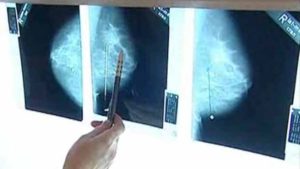 Another large study looking at screening mammograms for breast cancer has raised the issue of overdiagnosis and overtreatment once again. The purpose of mammography screening is to find cancer when it is small and so prevent cancer from growing and becoming advanced cancer. However, the researchers did not find this - there was a major increase in finding small cancers (the kind that may grow so slowly as to never cause any problems or that may even regress), but the rate of advanced cancers stayed the same.
Another large study looking at screening mammograms for breast cancer has raised the issue of overdiagnosis and overtreatment once again. The purpose of mammography screening is to find cancer when it is small and so prevent cancer from growing and becoming advanced cancer. However, the researchers did not find this - there was a major increase in finding small cancers (the kind that may grow so slowly as to never cause any problems or that may even regress), but the rate of advanced cancers stayed the same.
The problem of overdiagnosis (finding small tumors that may never cause problems) and overtreatment (treating unnecessarily), which is leading to medical experts "rethinking cancer screening" is a major shift in how cancer screening is being viewed for a number of cancers. This is because studies show that overall death rates are basically the same in screened vs non-screened persons for mammography, colon, prostate, and lung cancer screening (see post). The view of how cancer grows and spreads may have to be reexamined and changed. One possibility suggested by Dr. H. Gilbert Welch is that aggressive cancer is already "a systemic disease by the time it's detectable" (Oct. 28, 2015 post).
The following excerpts are from the thoughtful review of the study in Health News Review: Overdiagnosis of ductal carcinoma in situ: ‘the pathology equivalent of racial profiling’
Danish researchers are providing new evidence that many breast cancers found via screening mammograms don’t need to be treated. Women with these non-threatening tumors are said to be “overdiagnosed” with breast cancer. Overdiagnosis occurs when breast screening such as mammography detects small, slow-growing cancers that may never cause the patient any trouble. Yet, women diagnosed with such tumors are exposed to very real harms–possible surgery, chemotherapy, radiation, and living life as a “cancer patient.”
How much overdiagnosis are we talking about? If you don’t include cases of ductal carcinoma in situ (DCIS) in the tallies, anywhere from 14.7% to 38.6% of breast cancers found via screening represent overdiagnosis, the study authors found. The rate ranges from 24.4% to as high as 48.3% when DCIS is included.
DCIS is a collection of abnormal cells inside a milk duct that may–but usually doesn’t–break out to become invasive and potentially lethal cancer. About 60,000 women are told they have DCIS each year in the United States. Some experts estimate that up to 80% of women with DCIS found via screening may not need any treatment at all–and instead should just keep an eye on things. Obviously, women need to be fully and accurately informed about the benefits and risks — including the risk of overdiagnosis — before embarking on any decision to get screened for breast cancer or choosing a course of action following a diagnosis.
Otis Brawley, MD, Chief Medical Officer for the American Cancer Society, says it’s been difficult for modern medicine to wrap its brain around the concept of overdiagnosis. The natural inclination is to assume that cancerous-looking cells “will grow, spread, and eventually kill,” he writes in an editorial accompanying the Danish study. “However, some of these lesions may be genomically predetermined to grow no further and may even regress. In many respects, considering all small breast lesions to be deadly and aggressive types of cancer is the pathologic equivalent of racial profiling.
Excerpts from the original study from the Annals of Internal Medicine: Breast Cancer Screening in Denmark: A Cohort Study of Tumor Size and Overdiagnosis
Background: Effective breast cancer screening should detect early-stage cancer and prevent advanced disease. Objective: To assess the association between screening and the size of detected tumors and to estimate overdiagnosis (detection of tumors that would not become clinically relevant).... Setting: Denmark from 1980 to 2010. Participants: Women aged 35 to 84 years. Intervention: Screening programs offering biennial mammography for women aged 50 to 69 years beginning in different regions at different times.
Conclusion: Breast cancer screening was not associated with a reduction in the incidence of advanced cancer. It is likely that 1 in every 3 invasive tumors and cases of DCIS (ductal carcinoma in situ) diagnosed in women offered screening represent overdiagnosis (incidence increase of 48.3%).
Breast screening is associated with a substantial increase in the incidence of nonadvanced tumors and DCIS (ductal carcinoma in situ) in Denmark but not with a reduction in the incidence of advanced tumors, and the overdiagnosis rate is substantial. These findings support that screening has not accomplished the promise of a reduction in invasive therapy or disease-specific mortality.
